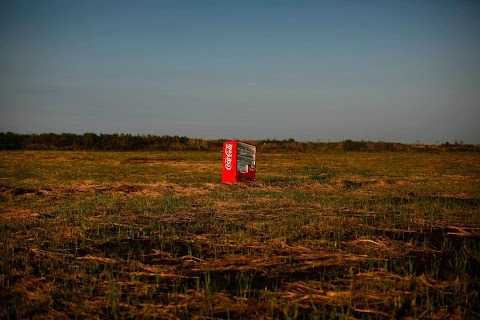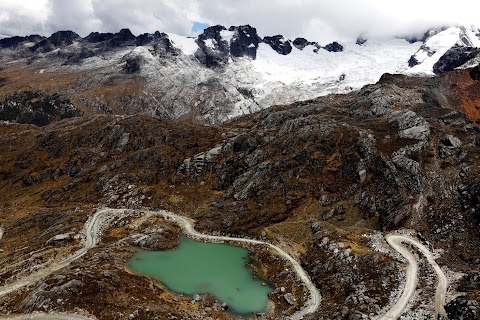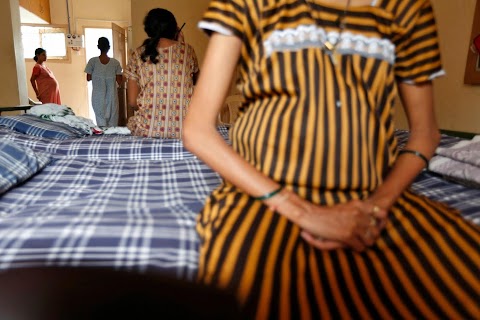
Land of jade
A man washes himself after the dirty and dangerous business of searching for jade amongst rubble dumped by mining companies in northern Myanmar.
Lumps of the precious stone can represent a fortune for "handpickers" like him. But the sums fetched by their rare big finds pale next to the staggering wealth extracted by Myanmar's military, the tycoons it helped enrich, and firms linked to the country where most jade ends up: China.

Traders inspect hunks of the green stone, particularly prized for its beauty and symbolism in China. "Gold is valuable, but jade is priceless," runs an old Chinese saying.
These stones are on display at a tea shop in Hpakant township, part of northern Myanmar’s Kachin State, a rugged region sandwiched between China and India. Nowhere on Earth does jade exist in such quantity and quality.
Despite the vast riches that lie beneath the earth, comparatively little wealth comes back to Myanmar’s government. Half of all jade sales are "unofficial" - that is, spirited over the border into China with little or no formal taxation. This represents billions of dollars in lost revenues that could be spent on rebuilding a nation shattered by nearly half a century of military dictatorship.
Foreign companies are not permitted to extract jade. But it is an open secret that most of the 20 or so largest operations in Hpakant are owned by Chinese companies or their proxies, say gem traders and other industry insiders in Kachin State.
"Of course, some (profit) goes to the government," said Yup Zaw Hkawng, chairman of Jadeland Myanmar, the most prominent Kachin mining company in Hpakant. "But mostly it goes into the pockets of Chinese families and the families of the former (Burmese) government."
Other players include the Union of Myanmar Economic Holdings Ltd (UMEHL), the investment arm of the country's much-feared military, and Burmese tycoons such as Zaw Zaw, chairman of Max Myanmar, who made their fortunes collaborating with the former junta.

Extracting jade is a perilous task for so-called handpickers like Too Aung, pictured holding out a piece of unwashed stone he found in a mine in Hpakant.
He is among the small-time prospectors who swarm across mountains of rubble dumped by mining companies – a dangerous job, especially when banks and slag heaps are destabilised by monsoon rain.
Landslides routinely swallow 10 or 20 men at a time, said Too Aung. "Sometimes we can't even dig out their bodies," he said. "We don't know where to look."
In 2002, at least a thousand people were killed when flood waters inundated a mine, Jadeland Myanmar chairman Yup Zaw Hkawng told Reuters. Deaths are common but routinely concealed by companies eager to avoid suspending operations, he said.

Lit by the dim light of a candle, middlemen and handpickers gather in a village near a jade mine in Hpakant to smoke yaba, opium and heroin.
A boom in Hpakant's population coincided with an exponential rise in opium production in Myanmar, the world's second-largest producer after Afghanistan. Its derivative, heroin, is cheap and widely available in Kachin State, and Hpakant's workforce seems to run on it.
About half the handpickers use heroin, while others rely on opium or alcohol, said Tin Soe, 53, a jade trader and a local leader of the opposition National League for Democracy party. "It's very rare to find someone who doesn't do any of these," he said.
Official figures on heroin use in Hpakant are hard to get. The few foreign aid workers operating in the area, mostly working with drug users, declined comment for fear of upsetting relations with the Myanmar government. But health workers say privately about 40 percent of injecting drug users in Hpakant are HIV positive - twice the national average.
Drug use is so intrinsic to jade mining that "shooting galleries" operate openly in Hpakant, with workers often exchanging lumps of jade for hits of heroin.
Slideshow

Handpickers search for jade as they clamber over piles of debris dumped by mining companies in Hpakant.

Men hack at the rubble as they search for the precious stones.

Kyaw Myo Aung, a 17-year-old handpicker, rests in his tent at a jade mine.

Two men walk among the rubble as they search for jade.

With their tools slung over their shoulders, handpickers return from work.

Trucks and other machinery stand parked in a company compound near a jade mine.

Traders wait for handpickers and middlemen to inspect their goods on so-called "jade tables" at a tea shop in Lone Khin village, in Hpakant township.

Tin Tun (right), a 38-year-old handpicker, sells the jade which he found after searching through the night at a mine.

Traders inspect jade at a tea shop in Lone Khin village.

The green stones are displayed at a market in Mandalay.

A trader looks at huge lumps of jade at Myanmar's 2011 Mid-Year Emporium for jade, gems and pearls.















